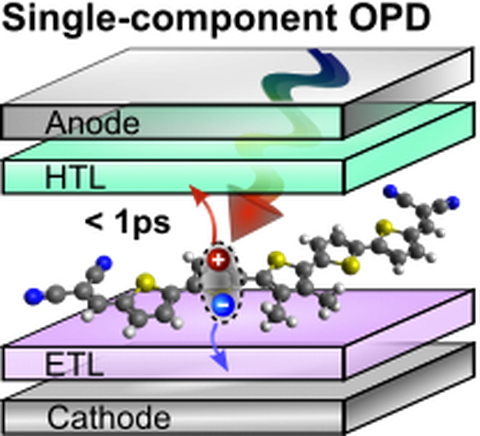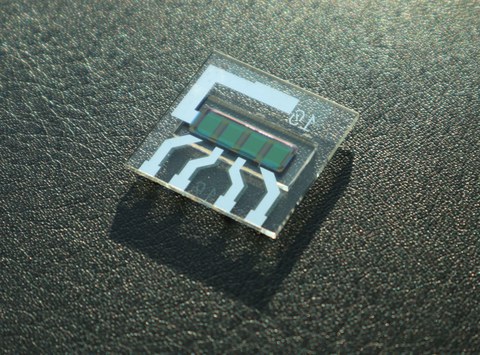Jan 22, 2025
Breaking Boundaries in Organic Photodetectors: High-Performance Single-Component Devices
A research team at TUD Dresden University of Technology has developed an innovative organic photodetector (OPD) with a simplified structure and outstanding performance. The breakthrough lies in the use of a single material in the photoactive layer - an approach that enables faster and more cost-effective industrial production without compromising on sensitivity. The results have now been published in the renowned journal “Advanced Materials”.
Organic solar cells (OSCs) and organic photodetectors (OPDs) consist of several layers that fulfill different functions. The core of these components is the so-called photoactive layer, in which the incident light is absorbed and free charge carriers are generated. In organic devices, typically two organic absorber molecules are combined in this active layer to enable efficient charge carrier generation. This approach has proven to be very successful for creating high performance OSCs and OPDs. However, this approach brings additional challenges for the industrial upscaling and long-term stability of the devices.
“Our goal was to overcome these challenges and develop a simpler but equally efficient alternative,” explains Dr. Johannes Benduhn, head of the OSENS (Organic sensors and solar cells) research group at the Institute of Applied Physics at Dresden University of Technology. The team developed an OPD whose photoactive layer consists of just one organic semiconductor material. The entire device structure can be produced using industry-proven vacuum evaporation technology, which means that the results can be quickly transferred to practical applications. Despite the simplified structure, the novel single-component (SC) OPD achieves an internal quantum efficiency of 20 percent and a very high sensitivity (D* = 1013 Jones), which is comparable to that of commercial silicon detectors. Using ultrafast transient absorption spectroscopy, the team, in cooperation with the University of Bern, was able to demonstrate that the charge carriers are generated within less than a picosecond (one trillionth of a second, 10⁻¹² seconds). These results were supplemented by extensive quantum chemical calculations in collaboration with the TU Munich, which revealed the reasons for the high efficiency of charge carrier generation.

Schematic layer structure of the organic photodetector with only one type of molecule in the photoactive layer. After the absorption of a photon, free charge carriers are generated within the first picosecond.
“With our work, we show that OPDs based on a single photoactive material represent a promising strategy to simplify the production of organic devices,” emphasizes Dr. Benduhn. “With the detailed investigation of charge carrier generation, we are also making an important contribution to the fundamental understanding of this promising technology.” The results demonstrate the potential of the single-component strategy for broad application in sensor technology and photonics. The simplification of production and the use of established processes pave the way for industrial implementation.
Original publication
J. Wolansky, C. Hoffmann, M. Panhans, L. C. Winkler, F. Talnack, S. Hutsch, H. Zhang, A. Kirch, K. M. Yallum, H. Friedrich, J. Kublitski, F. Gao, D. Spoltore, S. C. B. Mannsfeld, F. Ortmann, N. Banerji, K. Leo, J. Benduhn, Sensitive Self-Driven Single-Component Organic Photodetector Based on Vapor-Deposited Small Molecules. Adv. Mater. 2024, 2402834. https://doi.org/10.1002/adma.202402834
Contact
Dr. Johannes Benduhn
Institute of Applied Physics
TUD Dresden University of Technology
Email:
Tel. +49351 463-36446

